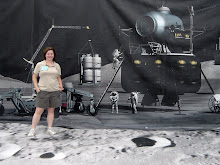In 2005, NASA selected a team for the development of a lunar lander spacecraft consistent with the goals set forth in the Administration's Renewed Spirit of Discovery and the National Aeronautics and Space Administration Authorization Act of 2005 (Public Law 109155) which called for a robust lunar robotic program, including robotic lunar landers. The National Research Council's report: The Scientific Context for Exploration of the Moon further supports robotic precursor missions to the Moon's surface and the valuable scientific resource such missions will provide for returning humans to the Moon. The Appropriations Committees agree that the NASA selected mission is of critical importance for the exploration vision. For this purpose, $42,000,000 is provided for this lunar lander mission.
From Senator Shelby's press release:
The Program Management Office for NASA’s Lunar Precursor and Robotic Program (LPRP) is based at Marshall Space Flight Center. The program includes the Lunar Reconnaissance Orbiter, LCROSS and Lunar Robotics Lander missions. These missions will gather critical data for the return of the United States to the moon and the potential for a long-term presence there. The bill includes a total of $271.5 million for LPRP, of which $42 million will be for the Lunar Lander mission and another $20 million will be for the program management office for activities associated with the Marshall Space Flight Center. The LPRP management office will be directly involved in the planning and oversight of future lunar robotic missions, integrating lunar data from NASA and other international missions, oversee technology development, and lead NASA’s public outreach and education activities for understanding the lunar environment.
“The LPRP program is an invaluable tool for the scientists and engineers at NASA to determine the best course of action when returning to the moon,” said Shelby. “The President, Congress and the scientific community have repeatedly pointed out the importance of a robotic lunar lander as a precursor to manned flights to the moon. I am glad the bill recognizes this need and Marshall’s role in accomplishing it.”
A couple things are playing out here. As NASA is underfunded in its ambitious Exploration program, it decided to cut the RLEP-2 lunar lander last year, saying all it needed for return to the Moon was "a good map." That might be true if you want to just land once, look around, and fly away. But this return to the Moon (we hope) will be so much more than that. The RLEP-2 mission was designed with two main objectives: characterize potential landing sites from the ground, with an eye on resources like hydrogen/water, and test critical human mission components like automated precision landing and structures.
There are a lot of ideas out there for ultra-low-cost lunar missions, like little rovers for the Google Lunar X-Prize and other small sats. I'm all for creative design of lunar micro-orbiter or micro-landers. They could send back some cool photos or movies, and it would certainly generate a lot of excitement, which is political capital. But, those class of spacecraft can't do the real tasks that scientists and engineers need as part of renewed exploration - that is, sophisticated sample analysis at multiple sites, self-similar platforms to test human lander components, and sample return. To accomplish these significant tasks, we need a more serious investment. Even if you think NASA costs are bloated, try cutting them in half. The MER rovers cost $850 to launch. Cut it in half, then half again for a single lander - you're still over $200M.
So, while RLEP-1 (aka Lunar Reconnaissance Orbiter) will get our "good map," there's still a lot of work to be accomplished by a serious lander, designed to address outstanding engineering and science goals that benefit planning across all of NASA. So keep your fingers crossed! I definitely am - combining lessons in design, operation, and public value of the MER rovers with forward-looking science and exploration goals on the Moon can't be anything but totally exciting - and why I came to work for NASA.

No comments:
Post a Comment